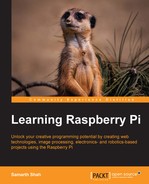In the previous section, you understood about image processing and its applications. To develop your image processing algorithms, you require some infrastructure/library or you would end up doing everything from scratch by yourself. In this book, we will use the OpenCV library for writing/developing image processing algorithms. OpenCV stands for open source computer vision. It has played a role in the growth of computer vision by enabling thousands of people to do more productive work in vision. With its focus on real-time vision, OpenCV helps students and professionals efficiently implement projects and jump-start research by providing them with a computer vision and machine learning infrastructure that was previously available only in a few mature research labs.
OpenCV is the world's most popular open source computer vision library, which contains over 500 functions that span many areas in vision as well as robotics. The library is written in C and C++ and it runs under all three major platforms, that is, Linux, Windows, and Mac OS X. It was designed for computational efficiency and with a strong focus on real-time applications. Today, whenever you talk about computer vision, machine learning will come into play some or the other way and vice versa. Because of the same reason, OpenCV contains a full, general purpose Machine Learning Library (MLL).
OpenCV is broadly structured into five main components that are mentioned in the following table:
|
Component Name |
Capabilities |
|---|---|
|
CV |
Image processing and higher-level computer vision algorithms |
|
MLL |
Machine Learning Library contains many statistical classifiers and clustering tools |
|
HighGUI |
GUI, Image, and Video I/O |
|
CXCORE |
Basic structures and algorithms, XML support, and drawing functions |
|
CvAux |
Background-foreground segmentation, Eigen objects, and Stereovision |
Although the preceding table explained the core components of OpenCV, researchers and scientists who extensively use OpenCV talk in the language of OpenCV modules. The following table contains a brief description of important modules:
|
Module |
Feature |
|---|---|
|
Core |
This is a compact module defining basic data structures, including the dense multidimensional array, Mat, and the basic functions used by all other modules |
|
Imgproc |
This is an image processing module that includes linear and nonlinear image filtering, geometrical image transformations (resizing, affine and perspective warping, and generic table-based remapping), color space conversion, histograms, and so on |
|
Video |
This is a video analysis module that includes motion estimation, background subtraction, and object tracking algorithms |
|
Calib3d |
This consists of basic multiple-view geometry algorithms, single and stereo camera calibration, object pose estimation, stereo correspondence algorithms, and elements of 3D reconstruction |
|
Features2d |
This consists of salient feature detectors, descriptors, and descriptor matchers |
|
Objdetect |
The features include detection of objects and instances of the predefined classes; for example, faces, eyes, mugs, people, and cars |
|
Highgui |
This is an easy-to-use interface for video capturing, image and video codecs as well as simple UI capabilities |
|
GPU |
The features of GPU include GPU-accelerated algorithms from different OpenCV modules |
OpenCV is distributed with a BSD license, which means that you can make a commercial application without revealing your source code. However, there are a few algorithms, despite being provided with complete source code inside OpenCV, which are patented.
This section will cover the installation procedure for Raspbian OS. As Raspbian OS is built on top of the Linux kernel, you will be able to install OpenCV on Raspberry Pi. Newer versions of the OpenCV library are released periodically. For the purpose of this book, the 2.4.1 (the first approach) and 2.4.10 (the second approach) versions have been the reference.
If you are not interested in installing the latest version of OpenCV, you can install it from the software repositories by running the following command in the terminal:
sudo apt-get update sudo apt-get install ipython python-opencv python-scipy python-numpy python-setuptools python-pip sudo apt-get install libopencv-dev sudo apt-get update
Check the OpenCV version:
pkg-config --modversion opencv
Use this approach if you want the latest/specific version of OpenCV. In this approach, OpenCV will be built from the source and you will have to install the dependencies prior to this:
sudo apt-get -y install build-essential cmake cmake-curses-gui pkg-config libpng12-0 libpng12-dev libpng++-dev libpng3 libpnglite-dev zlib1g-dbg zlib1g zlib1g-dev pngtools libtiff4-dev libtiff4 libtiffxx0c2 libtiff-tools libeigen3-dev sudo apt-get -y install libjpeg8 libjpeg8-dev libjpeg8-dbg libjpeg-progs ffmpeg libavcodec-dev libavcodec53 libavformat53 libavformat-dev libgstreamer0.10-0-dbg libgstreamer0.10-0 libgstreamer0.10-dev libxine1-ffmpeg libxine-dev libxine1-bin libunicap2 libunicap2-dev swig libv4l-0 libv4l-dev python-numpy libpython2.6 python-dev python2.6-dev libgtk2.0-dev
Don't worry if you don't understand what these lines mean. Once you have installed the dependencies, download the latest version of OpenCV from http://opencv.org/downloads.html (download OpenCV for Linux). Copy the opencv-2.4.10.zip to /home/pi directory and run the following commands:
unzip opencv-2.4.10.zip cd opencv-2.4.10 mkdir release cd release ccmake ../
Press g to generate a file. And finally, you need to build the OpenCV library and run the following command:
make sudo make install
Please note that this build usually takes more time (around 10 hours) on Raspberry Pi. That's it. OpenCV is now installed on Raspberry Pi.
